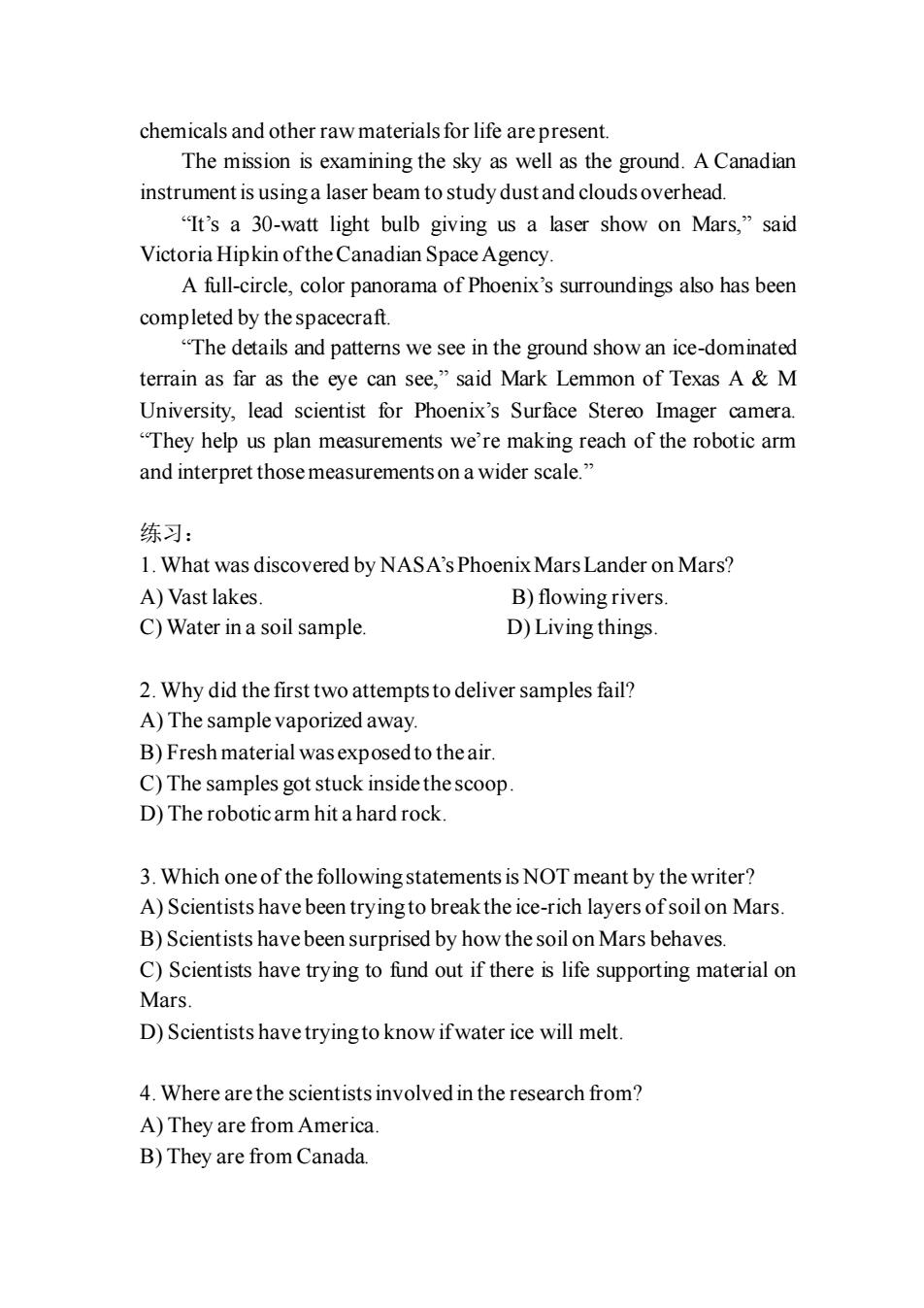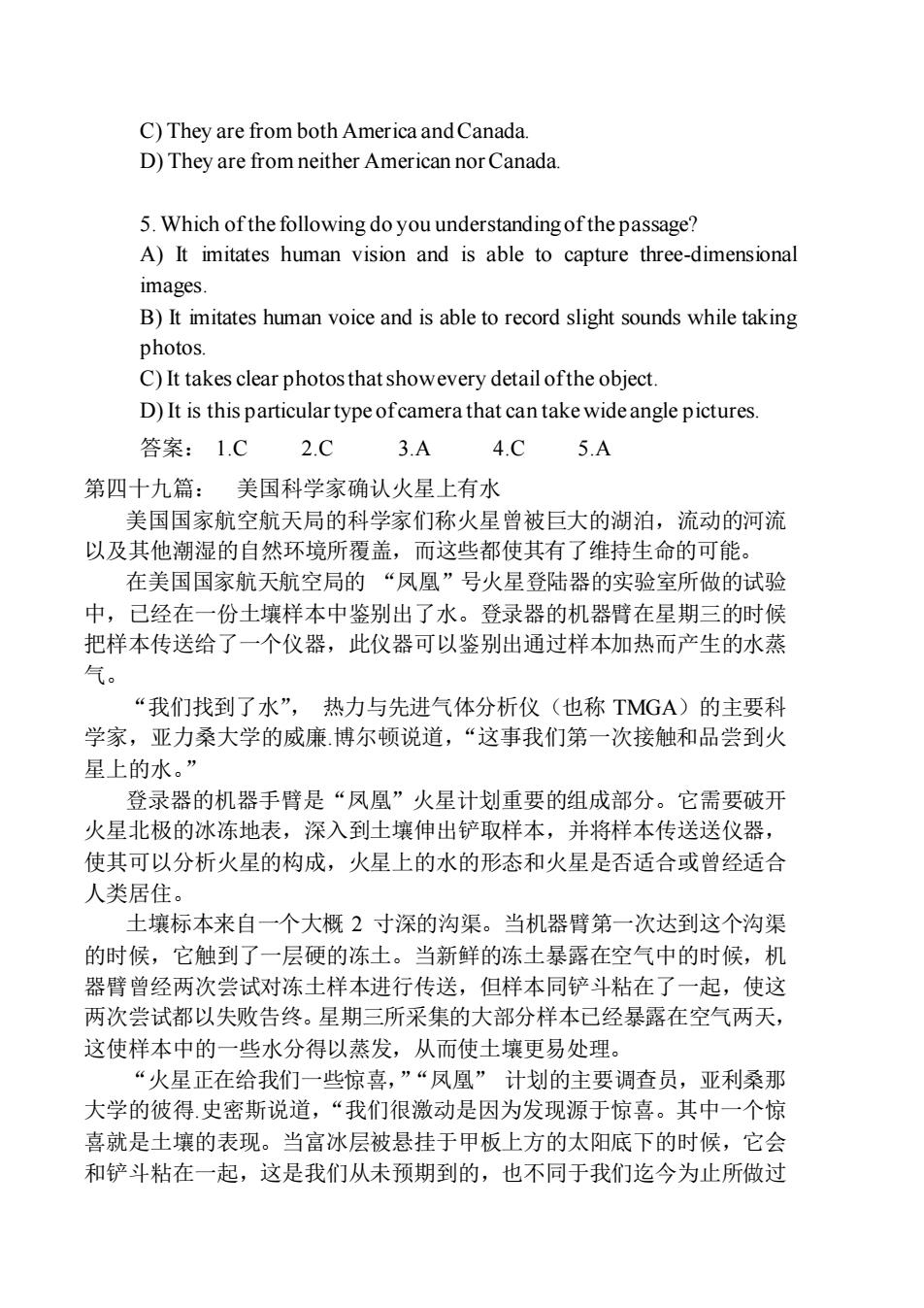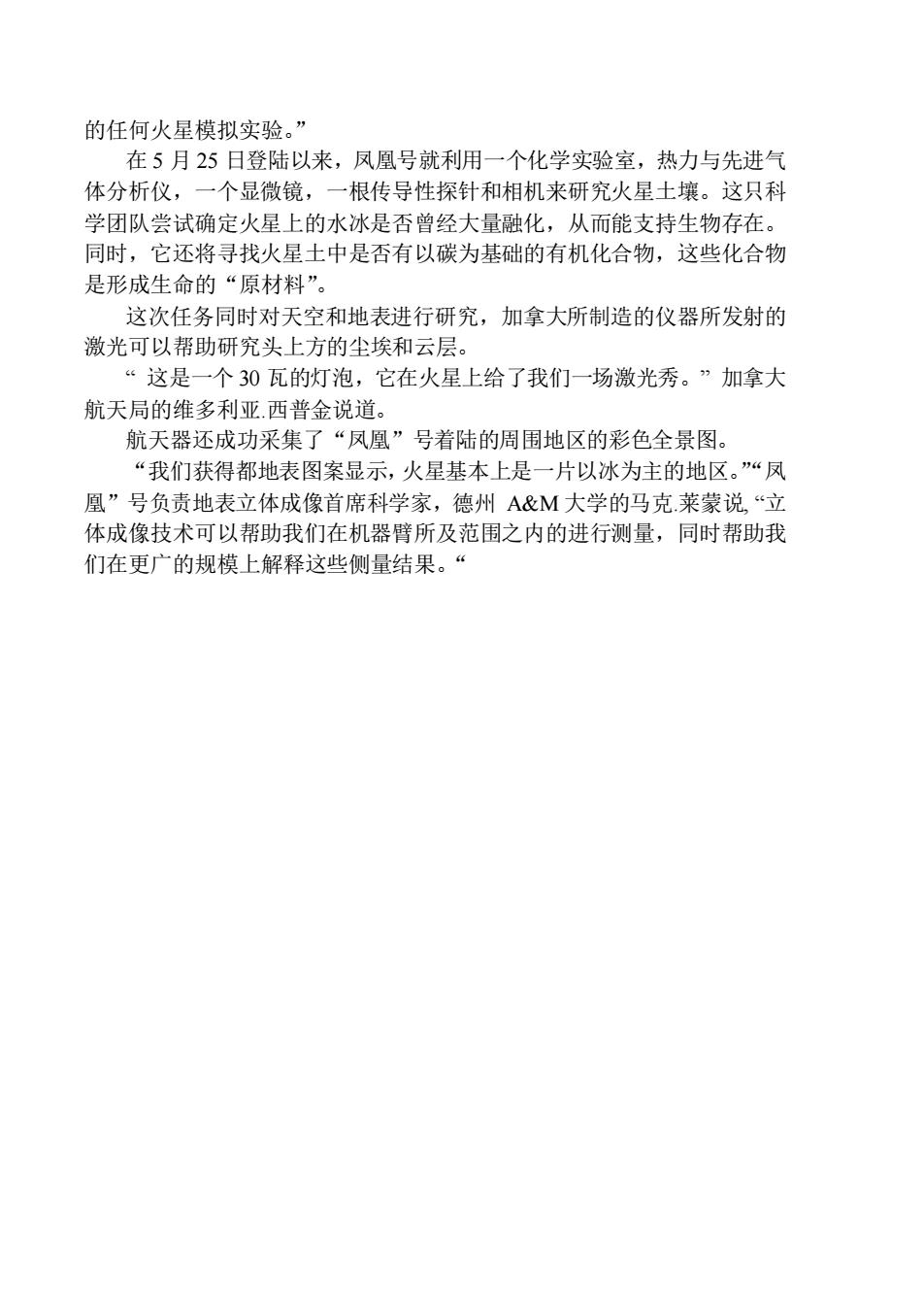
第四十九篇:U.S.ScientistsConfirm Water on Mars(A级)理工NASA scientists said that Mars was covered once by vast lakes,flowing rivers and a variety of other wet environments that had thepotentialto supportlifeLaboratory tests aboard NASA's Phoenix Mars Lander have identifiedwater in a soil sample. The lander's robotic arm delivered the sampleWednesday to an instrument that identifies vapors produced by the heatingofsamples."We have water," said William Boynton of the University of Arizona,lead scientist for the Thermal and Evolved-Gas Analyzer, or TEGA.“Thisis the first time Martian water has been touched and tasted."The robotic arm is a critical part of the Phoenix Mars mission. It isneeded to trench into the icy layers of northern polar Mars and deliversamples to instruments that will analyze what Mars is made of, what itswater is like, and whether it is or has ever been a possible habitat for lifeThesoilsamplecamefromatrenchapproximately2inchesdeepWhen the robotic arm first reached that depth, it hit a hard layer of frozensoil. Two attempts to deliver samples of icy soil on days when freshmaterial was exposed were foiled when the samples became stuck insidethe scoop. Most of the material in Wednesday's sample had been exposedtotheairfortwodays,lettingsomeofthewater inthesamplevaporizeawayandmakingthesoil easiertohandle."Mars is giving us some surprises," said Phoenix principalinvestigator Peter Smith of the University of Arizona.“We're excitedbecause surprises are where discoveries come from. One surprise is howthe soil is behaving. The ice-rich layers stick to the scoop when poised inthe sun above the deck, different from what we expected, from all the Marssimulationtestingwe'vedonesofar."Since landing on May 25, phoenix has been studying soil with achemistry lab, TEGA, a microscope, a microscope, a conductivity probeand cameras. The science team is trying to determine whether the water iceever thaws enough to be available for biology and if carbon-containing
第四十九篇: U.S. Scientists Confirm Water on Mars(A 级) 理工 NASA scientists said that Mars was covered once by vast lakes, flowing rivers and a variety of other wet environments that had the potential to support life. Laboratory tests aboard NASA’s Phoenix Mars Lander have identified water in a soil sample. The lander’s robotic arm delivered the sample Wednesday to an instrument that identifies vapors produced by the heating of samples. “We have water,” said William Boynton of the University of Arizona, lead scientist for the Thermal and Evolved-Gas Analyzer, or TEGA. “This is the first time Martian water has been touched and tasted.” The robotic arm is a critical part of the Phoenix Mars mission. It is needed to trench into the icy layers of northern polar Mars and deliver samples to instruments that will analyze what Mars is made of, what its water is like, and whether it is or has ever been a possible habitat for life. The soil sample came from a trench approximately 2 inches deep. When the robotic arm first reached that depth, it hit a hard layer of frozen soil. Two attempts to deliver samples of icy soil on days when fresh material was exposed were foiled when the samples became stuck inside the scoop. Most of the material in Wednesday’s sample had been exposed to the air for two days, letting some of the water in the sample vaporize away and making the soil easier to handle. “Mars is giving us some surprises,” said Phoenix principal investigator Peter Smith of the University of Arizona. “We’re excited because surprises are where discoveries come from. One surprise is how the soil is behaving. The ice-rich layers stick to the scoop when poised in the sun above the deck, different from what we expected, from all the Mars simulation testing we’ve done so far.” Since landing on May 25, phoenix has been studying soil with a chemistry lab, TEGA, a microscope, a microscope, a conductivity probe and cameras. The science team is trying to determine whether the water ice ever thaws enough to be available for biology and if carbon-containing

chemicals and other rawmaterialsfor life arepresent.The mission is examining the sky as well as the ground. A Canadianinstrument is usinga laser beamto study dust and cloudsoverhead.“It's a 30-watt light bulb giving us a laser show on Mars,"saidVictoria Hipkin ofthe Canadian Space Agency.A full-circle, colorpanorama of Phoenix's surroundings also has beencompletedbythespacecraft“The details and patterns we see in the ground show an ice-dominatedterrain as far as the eye can see,said Mark Lemmon of Texas A & MUniversity, lead scientist for Phoenix's Surface Stereo Imager camera.“They help us plan measurements we're making reach of the robotic armandinterpretthosemeasurementsona widerscale."练习:1. What was discovered by NASA's Phoenix Mars Lander on Mars?A) Vast lakes.B) flowingrivers.C) Water in a soil sampleD) Living things.2. Why did the first two attemptsto deliver samples fail?A) The sample vaporized away.B)Freshmaterialwasexposedtotheair.C) The samples got stuck inside the scoop.D)Theroboticarm hita hardrock3. Which one of the following statements is NOT meant by the writer?A)Scientistshavebeen tryingtobreaktheice-richlayersofsoilonMarsB) Scientists have been surprised by how the soil on Mars behaves.C) Scientists have trying to fund out if there is life supporting material onMarsD) Scientists havetryingtoknow ifwater ice will melt.4.Wherearethe scientists involvedintheresearchfrom?A) Theyare from America.B) They arefrom Canada
chemicals and other raw materials for life are present. The mission is examining the sky as well as the ground. A Canadian instrument is using a laser beam to study dust and clouds overhead. “It’s a 30-watt light bulb giving us a laser show on Mars,” said Victoria Hipkin of the Canadian Space Agency. A full-circle, color panorama of Phoenix’s surroundings also has been completed by the spacecraft. “The details and patterns we see in the ground show an ice-dominated terrain as far as the eye can see,” said Mark Lemmon of Texas A & M University, lead scientist for Phoenix’s Surface Stereo Imager camera. “They help us plan measurements we’re making reach of the robotic arm and interpret those measurements on a wider scale.” 练习: 1. What was discovered by NASA’s Phoenix Mars Lander on Mars? A) Vast lakes. B) flowing rivers. C) Water in a soil sample. D) Living things. 2. Why did the first two attempts to deliver samples fail? A) The sample vaporized away. B) Fresh material was exposed to the air. C) The samples got stuck inside the scoop. D) The robotic arm hit a hard rock. 3. Which one of the following statements is NOT meant by the writer? A) Scientists have been trying to break the ice-rich layers of soil on Mars. B) Scientists have been surprised by how the soil on Mars behaves. C) Scientists have trying to fund out if there is life supporting material on Mars. D) Scientists have trying to know if water ice will melt. 4. Where are the scientists involved in the research from? A) They are from America. B) They are from Canada

C)TheyarefrombothAmericaandCanadaD)TheyarefromneitherAmericannorCanada5.Which ofthefollowing doyou understandingofthepassage?A) It imitates human vision and is able to capture three-dimensionalimagesB) It imitates human voice and is able to record slight sounds while takingphotos.C)It takes clear photos that showeverydetail oftheobjectD)Itis thisparticulartypeofcamerathatcantakewideanglepictures答案:1.C2.C3.A4.C5.A第四十九篇:美国科学家确认火星上有水美国国家航空航天局的科学家们称火星曾被巨大的湖泊,流动的河流以及其他潮湿的自然环境所覆盖,而这些都使其有了维持生命的可能。在美国国家航天航空局的“凤凰”号火星登陆器的实验室所做的试验中,已经在一份土壤样本中鉴别出了水。登录器的机器臂在星期三的时候把样本传送给了一个仪器,此仪器可以鉴别出通过样本加热而产生的水蒸气。“我们找到了水”,热力与先进气体分析仪(也称TMGA)的主要科学家,亚力桑大学的威廉.博尔顿说道,“这事我们第一次接触和品尝到火星上的水。”登录器的机器手臂是“凤凰”火星计划重要的组成部分。它需要破开火星北极的冰冻地表,深入到土壤伸出铲取样本,并将样本传送送仪器,使其可以分析火星的构成,火星上的水的形态和火星是否适合或曾经适合人类居住。土壤标本来自一个大概2寸深的沟渠。当机器臂第一次达到这个沟渠的时候,它触到了一层硬的冻土。当新鲜的冻土暴露在空气中的时候,机器臂曾经两次尝试对冻土样本进行传送,但样本同铲斗粘在了一起,使这两次尝试都以失败告终。星期三所采集的大部分样本已经暴露在空气两天,这使样本中的一些水分得以蒸发,从而使土壤更易处理。“火星正在给我们一些惊喜,”“凤凰”计划的主要调查员,亚利桑那大学的彼得.史密斯说道,“我们很激动是因为发现源于惊喜。其中一个惊喜就是土壤的表现。当富冰层被悬挂于甲板上方的太阳底下的时候,它会和铲斗粘在一起,这是我们从未预期到的,也不同于我们迄今为止所做过
C) They are from both America and Canada. D) They are from neither American nor Canada. 5. Which of the following do you understanding of the passage? A) It imitates human vision and is able to capture three-dimensional images. B) It imitates human voice and is able to record slight sounds while taking photos. C) It takes clear photos that show every detail of the object. D) It is this particular type of camera that can take wide angle pictures. 答案: 1.C 2.C 3.A 4.C 5.A 第四十九篇: 美国科学家确认火星上有水 美国国家航空航天局的科学家们称火星曾被巨大的湖泊,流动的河流 以及其他潮湿的自然环境所覆盖,而这些都使其有了维持生命的可能。 在美国国家航天航空局的 “凤凰”号火星登陆器的实验室所做的试验 中,已经在一份土壤样本中鉴别出了水。登录器的机器臂在星期三的时候 把样本传送给了一个仪器,此仪器可以鉴别出通过样本加热而产生的水蒸 气。 “我们找到了水”, 热力与先进气体分析仪(也称 TMGA)的主要科 学家,亚力桑大学的威廉.博尔顿说道,“这事我们第一次接触和品尝到火 星上的水。” 登录器的机器手臂是“凤凰”火星计划重要的组成部分。它需要破开 火星北极的冰冻地表,深入到土壤伸出铲取样本,并将样本传送送仪器, 使其可以分析火星的构成,火星上的水的形态和火星是否适合或曾经适合 人类居住。 土壤标本来自一个大概 2 寸深的沟渠。当机器臂第一次达到这个沟渠 的时候,它触到了一层硬的冻土。当新鲜的冻土暴露在空气中的时候,机 器臂曾经两次尝试对冻土样本进行传送,但样本同铲斗粘在了一起,使这 两次尝试都以失败告终。星期三所采集的大部分样本已经暴露在空气两天, 这使样本中的一些水分得以蒸发,从而使土壤更易处理。 “火星正在给我们一些惊喜,”“凤凰” 计划的主要调查员,亚利桑那 大学的彼得.史密斯说道,“我们很激动是因为发现源于惊喜。其中一个惊 喜就是土壤的表现。当富冰层被悬挂于甲板上方的太阳底下的时候,它会 和铲斗粘在一起,这是我们从未预期到的,也不同于我们迄今为止所做过

的任何火星模拟实验。”在5月25日登陆以来,凤凰号就利用一个化学实验室,热力与先进气体分析仪,一个显微镜,一根传导性探针和相机来研究火星土壤。这只科学团队尝试确定火星上的水冰是否曾经大量融化,从而能支持生物存在。同时,它还将寻找火星土中是否有以碳为基础的有机化合物,这些化合物是形成生命的“原材料”。这次任务同时对天空和地表进行研究,加拿大所制造的仪器所发射的激光可以帮助研究头上方的尘埃和云层。“这是一个30瓦的灯泡,它在火星上给了我们一场激光秀。”加拿大航天局的维多利亚.西普金说道。航天器还成功采集了“凤凰”号着陆的周围地区的彩色全景图。“我们获得都地表图案显示,火星基本上是一片以冰为主的地区。”“凤凰”号负责地表立体成像首席科学家,德州A&M大学的马克莱蒙说“立体成像技术可以帮助我们在机器臂所及范围之内的进行测量,同时帮助我们在更广的规模上解释这些侧量结果
的任何火星模拟实验。” 在 5 月 25 日登陆以来,凤凰号就利用一个化学实验室,热力与先进气 体分析仪,一个显微镜,一根传导性探针和相机来研究火星土壤。这只科 学团队尝试确定火星上的水冰是否曾经大量融化,从而能支持生物存在。 同时,它还将寻找火星土中是否有以碳为基础的有机化合物,这些化合物 是形成生命的“原材料”。 这次任务同时对天空和地表进行研究,加拿大所制造的仪器所发射的 激光可以帮助研究头上方的尘埃和云层。 “ 这是一个 30 瓦的灯泡,它在火星上给了我们一场激光秀。” 加拿大 航天局的维多利亚.西普金说道。 航天器还成功采集了“凤凰”号着陆的周围地区的彩色全景图。 “我们获得都地表图案显示,火星基本上是一片以冰为主的地区。”“凤 凰”号负责地表立体成像首席科学家,德州 A&M 大学的马克.莱蒙说, “立 体成像技术可以帮助我们在机器臂所及范围之内的进行测量,同时帮助我 们在更广的规模上解释这些侧量结果